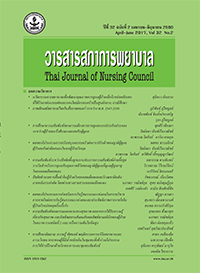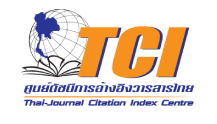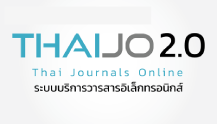การศึกษาความสัมพันธ์ของความต้องการการดูแลแบบประคับประคองระหว่างผู้ป่วยมะเร็งศีรษะและคอกับผู้ดูแล
Keywords:
ความต้องการ, การดูแลแบบประคับประคอง, ผู้ป่วยมะเร็งศีรษะและคอ, ผู้ดูแล, palliative care needs, head & neck cancer patients, caregiversAbstract
Abstract
Objective: To examine head & neck cancer patients’ pre- and post-treatment
needs for palliative care and their relationship with their caregivers.
Design: Correlational descriptive research.
Methodology: The participants were 45 head & neck cancer patients and their
caregivers. The patients were hospitalised at a tertiary hospital in Bangkok. The research
instruments consisted of (i) a general information and illness history form; and (ii) a
palliative care problem-and-need questionnaire for the patients and their caregivers.
The data were analysed using descriptive statistics and Spearman Correlation Analysis.
Results: The study showed that the patients’ primary pre-treatment need was fnancial
support (22.2%), whilst their primary post-treatment need was disease-related information
(20%). Their caregivers, on the other hand, identifed palliative care assistance for the patients
as their primary need, both before and after treatment (15.6% and 11.1%, respectively).
A statically signifcant relationship was found between the patients’ and their caregivers’
overall pre- and post-treatment palliative care needs (rs = .47, rs = .46, p < .01).
Category-based analysis showed that both the patients’ and their caregivers’ primary
pre-treatment needs were signifcantly related, and they mainly concerned social and fnancial
support (rs = .36, p < .05, rs = .52, p < .01, respectively). After treatment, a statistically signifcant
relationship was also found between the patients’ and their caregivers’ needs, which mainly
concerned spiritual and fnancial support (rs = .34, p < .05, rs = .39, p < .01, respectively).
Recommendations: It is suggested that nurses play an active role in assessing
patients’ pre- and post-treatment problems and palliative care needs. This practice could
lead to more effective counselling and problem-solving approaches, which ultimately
could improve palliative care methods for head & neck cancer patients.
References
2. Department of Medicine Services Ministry of Public Health. Statistical report 2012: ICT-Ministry of Public Health;2013. (In Thai)
3. Murphy BA, Gilbert J. Oral cancers: supportive care issues. Periodontol 2000 2011;57(1):118-31.
4. Pauloski BR, Rademaker AW, Logemann JA, Lazarus CL, Newman L, Hamner A, et al. Swallow function and perception of dysphagia in patients with head and neck cancer. Head Neck 2002;24:555-65.
5. Bower WF, Vlantis AC, Chung TML, Cheung SKC, Bjordal K, van Hasselt CA. Quality of life in head and neck cancer patients after surgical resection: translation into Cantonese and validation of the EORTC QLQ-H& N35. ACta Oto-Laryngologica 2009;129(7): 779-85.
6. Zeller JL. High suicide risk found for patients with head and neck cancer. JAMA 2006;296(14):1716-7.
7. Ledeboer QC, van der Velden LA, De Boer MF, Feenstra L, Pruyn JF. Palliative care for head and neck cancer patients in general practice. Acta Otolaryngol 2006;126(9):975-80.
8. Bruera E, Hui D. Integrating supportive and palliative care in the trajectory of cancer: establishing goals and models of care. J Clin Oncol 2010;28(25):4013-7.
9. Given BA, Given CW, Sherwood PR. Family and caregiver needs over the course of the cancer trajectory. J Support Oncol 2012;10(2):57-64.
10. Ross S, Mosher C, Ronis-Tobin V, Hermele S, Ostroff J. Psychosocial adjustment of family caregivers of head and neck cancer surviors. Support Care Cancer 2010;18(2):171-8.
11. Baghi M, Wagenblast J, Hambek M, Radeloff A, Gstoettner W, Scherzed A, et al. Demands on caring relatives of head and neck cancer patients. Laryngoscope 2007;117(4):712-6.
12. Shelby RA, Taylor KL, Kerner JF, Coleman E, Blum D. The role of community-based and philanthropic organizatons in meeting cancer patient and caregiver needs. CA Cancer J Clin 2002;52(4):229-46.
13. Deshields TL, Applebaum AJ. The time is now: Assessing and addressing the needs of cancer caregivers. Cancer 2015;121:1344-6.
14. Roy C. The Roy adaptation model. 3rd ed. Upper Saddles River, NJ: Pearson; 2008.
15. Masters K. Nursing theories: a framework for professional practice. USA: Jones & Bartlett Learning; 2012.
16. Wolf FM, Cornell RG. Interpreting behavioral, biomedical, and psychological relationships in chronic disease from 2 x 2 tables using correlation. J Chronic Dis 1986;39(8):605-8.
17. Melzack R. The short-form Mcgill pain quesionnaire. Pain 1987;30(2):191-7.
18. Kitisomprayoonkul W, Klaphajone J, Kovindha A. Thai short-form McGill pain questionnaire. [Validation studies]. J Med Assoc Thai 2006;89(6):846-53.
19. Osse BHP, Vernooij-Dassen MJFJ, Schadé E, Grol RPTM. A practical instrument to explore patients’ needs in palliative care: The problems and needs in palliative care quesionnaire-short version. Palliat Med 2007;21(5):391-9.
20. Osse BHP, Vernooij-Dassen MJFJ, Schadé E, Grol RPTM. Problems experionced by the informal caregivers of cancer patients and their needs for support. Cancer Nurs 2006;29(5):378-88.
21. Rigoni L, Bruhn RF, De Cicco R, Kanda JL, Matos LL. Quality of life impairment in pateints with head and neck cancer and their caregivers: a comparative study. Braz J Otorhinolaryngol 2016;82(6):680-6.
22. Rogers SN, Harvey-Woodworth CN, Hare J, Leong P, Lowe D. Patients’ perception of the financial impact of head and neck cancer and the relationship to health related quality of life. Br J Oral Maxillofac Surg 2012; 50(5):410-6.
23. Millsopp L, Brandom L, Humphris G, Lowe D, Stat C, Rogers S. Facial appearance after operations for oral and oropharyngeal cancer: a comparison of casenotes and patient-completed questionnaire. Br J Oral Maxillofac Surg 2006;44(5):358-63.
24. Balfe M, O’ Brien K, Timmons A, Butow P, O’ Sullivan E, Gooberman-Hill R, et al. What factors are asssociated with posttraumatic growth in head and neck cancer carers?. Eur J Oncol Nurs 2016;21:31-7.
25. Luvira V, Srikha D, Pairojkul S. Community-based palliative care by volunteers: perceptions of village health volunteers in a community of Khon Kaen province. SMJ 2013;28(2):266-70. (In Thai)
26. Penner JL. Psychosocial care of patients with head and neck cancer. Semin Oncol Nurs 2009;25(3): 231-41.
27. Precious E, Haran S, Lowe D, Rogers SN. Head and neck cancer patients’ perspective of carer burden. Br J Oral Maxillofac Surg 2012;50(3):202-7.
28. Gozum S, Akçay D. Response to the needs of Turkish chemotherapy patients and their families. Cancer Nurs 2005;28(6):469-75.
29. Sukaseme S, Aphichato A, Chuapraphaisilp A. Quality of life in cancer patients receiving radiotherapy. Songklanagarind Journal of Nursing 1996;16(3): 9-26. (In Thai)
30. Clark D, Wright M, Bath P, Gatrell A. The international observatory on end of life care: a new research and development initiative in palliative care. Prog Palliat Care 2003;11(3):136-8.






